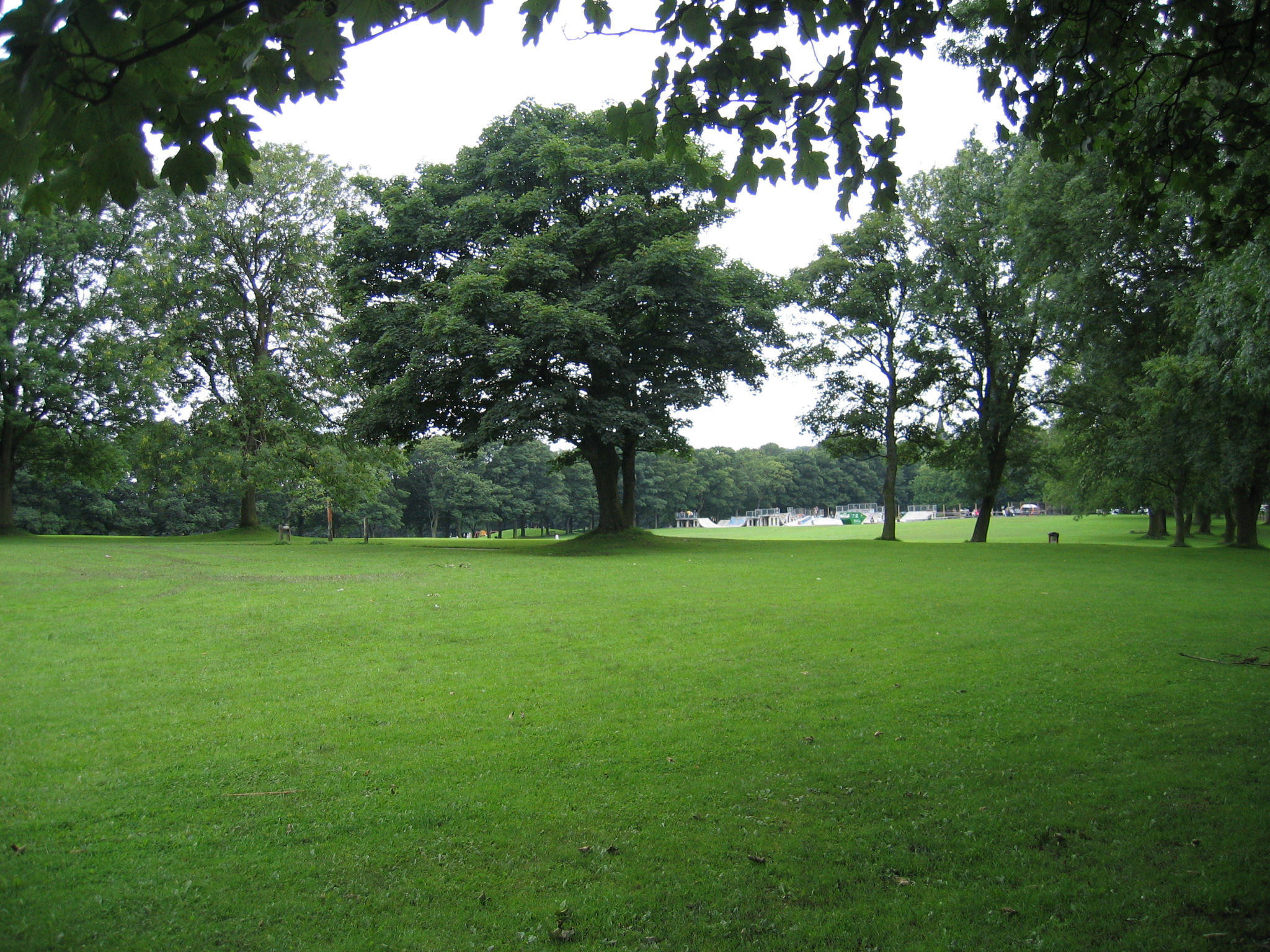- Woodhouse Moor
Infobox park
park=Woodhouse Moor
image size=
caption=Woodhouse Moor Park
type= Parkland, woodland, gardens
location=Leeds ,West Yorkshire ,England
coordinates= coord|53|48|39|N|1|33|40|W|display=inline,title
size= 26 hectares
opened=1857
operator=Leeds City Council
annual visitors= |status= Open all yearWoodhouse Moor is an open space approximately one mile (1.6 km) from
Leeds city centre,West Yorkshire ,England . Today it consists of 3 parts: a formal park, Woodhouse Moor Park (sometimes referred to as Hyde Park - see below), of around 26 hectares in area cite web |url=http://www.leeds.gov.uk/Environment_and_planning/Parks_and_open_spaces/Parks_and_open_spaces__general_information/page.aspx?pageID=dae9ad2c-6ecf-427c-8f78-05792d2e40ab |title= Woodhouse Moor Park |accessdate=2007-09-14 |publisher=Leeds City Council ] on the west of Woodhouse Lane (the A660), and two other open areas on the east of it. These are known as the Monument (or Upper) and Cinder (or Gravel, or Lower) Moors which are used for events such as circuses and sporting matches, and sometimes car parking. Woodhouse Moor is north-west of Leeds city centre and is bounded by Woodhouse, theUniversity of Leeds , Burley, Hyde Park, andHeadingley .As of 2005 the park had just under 3 million visits a year and is the second most popular urban park in Leeds [cite web |url=http://www.leedsinitiative.org/initiativeDocuments/20061214_57596988.pdf |title=A Parks and Green Space Strategy for Leeds |accessdate=2007-09-14 |publisher=
Leeds City Council |date=2006 |format=PDF |pages=67 ] . The park has five main paths which meet in the centre, each is tree-lined and they divide the park into different areas of usage.History
The park was once part of a much larger moor of the same name, including land now occupied by
Leeds University . As high position above Leeds, it has been a military rallying point, and Rampart Road is named after the ramparts which were once there.E. Bews (1998) "Woodhouse Moor" pp 109-118 "in" L. S. Tate "Aspects of Leeds" ISBN 1-871647-38-X] During theEnglish Civil War , in 1642, Parliamentary forces led by Thomas Fairfax massed on Woodhouse Moor before taking Leeds from the royalists. [cite web |url=http://dnausers.d-n-a.net/leodis-leeds/civilwar.html |title=The Civil War comes to Leeds |accessdate=2007-09-14 |author=Keith Feeney]The land was acquired by Leeds Corporation for the sum of £3,000 on 19 May, 1857 [cite web |url=http://www.leodis.net/display.aspx?resourceIdentifier=2007711_164059&DISPLAY=FULL |title=Aerial View of Woodhouse Moor |accessdate=2007-09-14 |publisher=Leodis] . Clarendon Road, which runs alongside Woodhouse Moor, used to be Reservoir Street because of a
reservoir belonging to Leeds CorporationWaterworks . The reservoir was begun in 1837, aftercholera epidemics swept Leeds in 1832, and was covered over in 1863. Two stone lodges were built alongside the reservoir in 1840; one still stands (behind the gardener's cottage near the Victoria Monument); the other was converted into an observatory in 1906, and subsequently demolished.In 1858 Queen Victoria, in Leeds for the opening of the Town Hall, visited the Moor and listened to 26,000
Sunday School children sing hymns as the teachers tried to control them using placards with instructions such as 'Prepare to Cheer', 'Sing', 'Silence', and 'Dismiss'. [cite web |url=http://www.leeds.gov.uk/discover/discovery.asp?pageno=&page=200335_519878567&topic=200335_316509426&subsection=2003611_484569729 |title=Leeds Town Hall Opening |accessdate=2007-09-14 |publisher=Leeds City Council | date=2003-03-25]The road north of Woodhouse Moor Park is called Hyde Park road, indicating the former name. As with
Hyde Park, London this was a place where crowds would gather to hear public speakers, on specially built platforms.In the beginning of the 20th century, there were extensive pleasure gardens and features such as a bandstand and (from 1919) a
First World War tank. With theSecond World War , the tank was melted down and the Moor given over to more utilitarian purposes such as air raid shelters and allotments (some of which still exist). In 1937 some statues were moved from the centre of Leeds, to the Moor, including those of Queen Victoria and Sir Henry Marsden.The Moor was on of the locations of the
Festival of Britain in 1951, opened by the Princess Royal (later Queen Elizabeth II).tatues
There are several Victorian statues in the park: near the Woodhouse Lane, Clarendon Road junction is the Victoria Monument, by
George Frampton [cite web |url=http://pmsa.cch.kcl.ac.uk/LL/MSSH0004.htm |title=Queen Victoria Monument |accessdate=2007-09-14 |author= [http://www.pmsa.org.uk Public Monument and Sculpture Association] ] it was originally placed at Leeds town hall. Near Hyde Park corner is a statue ofSir Robert Peel byWilliam Behnes and at the opposite corner where Moorland Road meets Clarendon road is a statue of the Duke of Wellington byCarlo Marochetti . The statue on Monument Moor, on the opposite side of theA660 to the main body of the Moor, is ofHenry Rowland Marsden , a Liberal Mayor of Leeds for 1875-6. These statues are regularly the subject of pranks by mischievous students, and can often be seen with paint on them ortraffic cones on their heads.Activities
The park has playgrounds, allotments, skateboard and
BMX park, formal gardens, and large areas of grassland. It is also the southern end of theMeanwood Valley Trail , a footpath through woods and parks toGolden Acre Park .Unity Day [ [http://www.unityday.freeserve.co.uk/ Unity Day] ] is held in the park on the first Saturday of August to help unite the community following riots in the local area in1995 . There are various myths that Woodhouse Moor is the setting for multiple sexual assaults upon male students. Many students and local residents avoid the parks busy paths after dark as a precaution. These rumours appear to be unfounded, with violent crime figures for the Hyde Park area comparatively lower than in otherLeeds suburbs.2000 saw a spate of street robberies which featured on BBC's "Crimewatch ", with some victims being assaulted on Chesnut Avenue (see "Most Burgled Street in England" inHyde Park, Leeds article).Gallery
Images of Woodhouse Moor
References
External links
* [http://www.leeds.gov.uk/About_Leeds/Places_to_visit/Parks_and_gardens/Woodhouse_Moor_Park.aspx Leeds City Council Website] Woodhouse Moor Park
* [http://www.unityday.org.uk/ Unity Day website]
Wikimedia Foundation. 2010.
